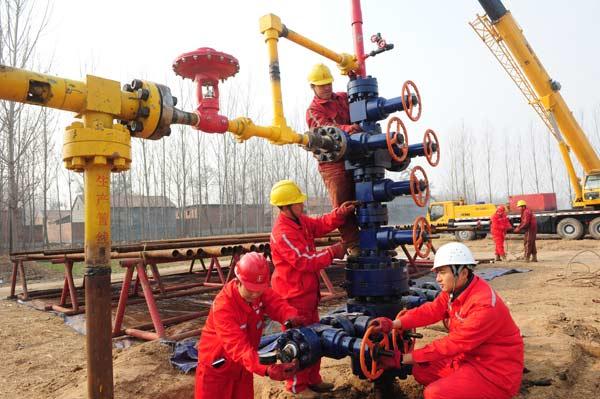
CHINA INCREASES EFFICIENCY

Expect no radical "big bang" in China's shake-up of its giant state-run energy firms, but a series of experimental and incremental steps that Beijing has quietly embarked on may still bring meaningful change to an economically crucial sector.
Reform of sprawling state-owned enterprises (SOEs) to improve efficiency is a priority for China's leaders as growth slows in the world's second biggest economy, and was a key plank of the country's latest five-year plan agreed in 2015.
For some sectors that means mega-mergers, such as the marriage last year of top train makers China CNR Corp Ltd and China CSR Corp Ltd, to create national champions with the heft to compete on the world stage.
Speculation of a similar tie-up in the oil sector has proved unfounded, and Beijing-based industry executives say the bolder privatization proposals put forward by some government think-tanks - from opening mining rights to private bidders to breaking up PetroChina's pipeline monopoly - look equally remote.
Instead, Beijing is ushering in moderate pilot-based changes - granting private refiners oil licenses, encouraging a first private-led mega-refinery and overhauling the management of state-run assets - steps that seem fragmented but share a common goal of boosting efficiency across the sector.
China's energy sector is dominated by three state giants: China National Petroleum Corp (CNPC), China Petrochemical Corp and China National Offshore Oil Corp.
Despite decade-low oil prices, the listed arms of that trio - PetroChina (0857.HK), Sinopec Corp (0386.HK) and CNOOC Ltd (0883.HK) - booked a combined $600 billion revenue last year and contributed nearly 9 percent of all the profits from China's state-owned enterprises (SOE), official data showed.
"At the end of the day, big SOEs like CNPC and Sinopec are seen as key stabilizing factors to the national economy," said a senior PetroChina official.
"That means the government wants to maintain strong control over the sector and changes will be paced and moderate."
SERVICES FIRMS TO LIST
Spinning off parts of the energy giants' businesses will be one element of the reform package.
Top energy firm CNPC, China's leader in oil and gas exploration and production, will spend the next 2-3 years restructuring its enormous services division, which employs nearly 1 million people, executives said.
CNPC is aiming to set up three or four companies covering oilfield drilling, refinery engineering and financial services, with a target to list them on the stock market by around 2018, according to two senior CNPC officials.
"Timing could be perfect as we expect oil prices to climb back to $70 and above by 2018, which should help CNPC fetch attractive valuations for the oil/gas services engineering IPOs," said Gordon Kwan of Nomura research.
The rise of independent refiners - so-called "teapots" - since Beijing allowed them to start importing crude in July last year is already disrupting the refining business of Sinopec and PetroChina.
Their emergence has also had a huge impact on global oil markets as their crude imports have acted as a core pillar of support in an otherwise oversupplied market.
The next step could be bringing "mixed ownership" - the model Beijing has touted for introducing private investment in its most far-reaching overhaul of the state sector in two decades - to larger-scale operations.
A pilot scheme in Zhoushan, eastern China, demonstrates how that might look in the energy sector - private investors are leading a project for a $15 billion mega-petrochemical complex that could compete head-to-head with Sinopec.
ASSET MANAGEMENT MODEL
A low-profile experiment at a Sinopec overseas unit badly hit by the collapse in the price of oil over the last 18 months offers evidence that changes in how state assets are managed may be the next phase of the reform process.
Orchestrated by the state asset regulator, Sinopec last month tapped China Chengtong Holdings Group Ltd and China Reform Holdings as strategic investors at SIPC, its overseas exploration and production vehicle that operates multi-billion assets that include Canadian oil sands and deep-sea concessions in Brazil.
The two firms, both state-owned investment vehicles, will hold a combined 70 percent stake in SIPC. Sinopec holds the rest and remains as the operator.
"SIPC was picked as a pilot firm ... The model could eventually be the way to reform SOEs, to change companies' management behaviors and capital structures," said a Sinopec executive involved in this pilot scheme.
The aim is to allow specialist firms such as SIPC to focus on running the operational side of their business profitably, while leaving strategic decisions to more market-minded managers such as Chengtong.
Driven in part by Beijing's mandate to pursue "energy security", many of SIPC's assets were bought by Sinopec between 2010 and 2013, when oil averaged more than $100 a barrel, and would not command the same valuations now.
"This is what SOE reform will look like," said Michal Meidan, China expert at consultancy Energy Aspects. "You can call it a bailout or just an asset transfer... getting a more commercially minded, albeit state-owned, investor to try and increase profitability or minimize losses."
-----
Earlier:






